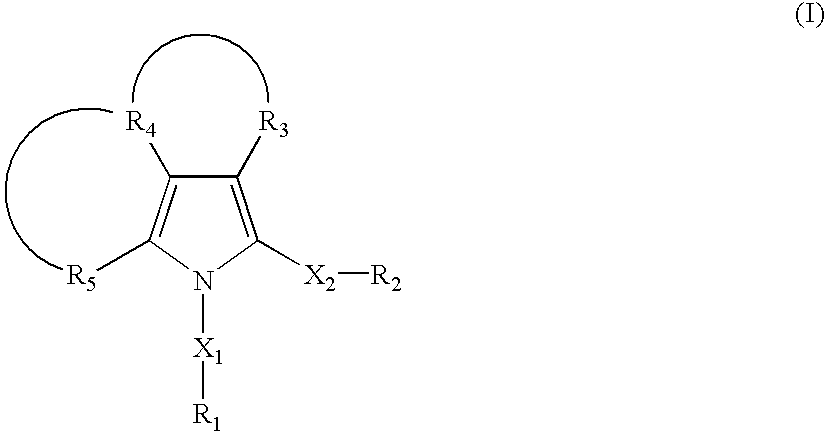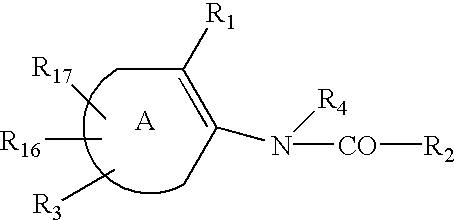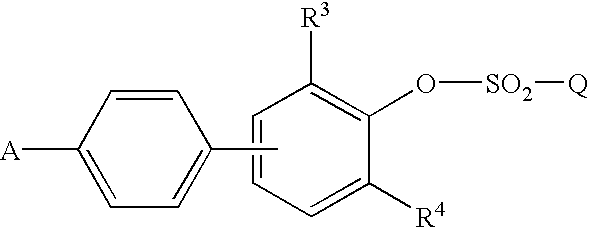Tyrosine phosphatase inhibitors
a phosphatase inhibitor and tyrosine technology, applied in the field of pyrrole compounds, can solve the problem that none of the above-mentioned pyrrole compounds is reported
- Summary
- Abstract
- Description
- Claims
- Application Information
AI Technical Summary
Benefits of technology
Problems solved by technology
Method used
Image
Examples
example 1
Ethyl (2R)-2-{4-[1-(4-bromophenyl)-1H-pyrrol-2-yl]phenoxy}-3-phenylpropanoate
(1) 3-(5,5-Dimethyl-1,3-dioxan-2-yl)-1-propanol
[0407]To an aqueous solution of 2,2-dimethyl-1,3-propanediol (100 g, 960 mmol) (200 ml) was added concentrated hydrochloric acid (20 ml) and 2,3-dihydrofuran (66.1 ml, 874 mmol) and the mixture was stirred at room temperature for 12 hours. The reaction solution was adjusted to pH 9 with aqueous 5 N sodium hydroxide and extracted with chloroform. The extract was dried over magnesium sulfate anhydride and the solvent was removed under reduced pressure. The residue was distilled under reduced pressure to give the object compound as an oily substance. 126 g (yield: 82.9%)
[0408]1H-NMR (CDCl3) δ; 0.73 (3H, s), 1.19 (3H, s), 1.67-1.81 (4H, m), 2.49 (1H, bs), 3.41-3.65 (6H, m), 4.48 (1H, t, J=4.4 Hz).
[0409]IR (KBr) cm−1; 2932, 2853, 1471, 1394, 1142, 1041, 980, 926.
(2) 3-(5,5-Dimethyl-1,3-dioxan-2-yl)-1-propanal
[0410]To a solution of oxalyl chloride (16.6 ml, 190 mmol)...
example 2
(2R)-2-{4-[1-(4-Bromophenyl)-1H-pyrrol-2-yl]phenoxy}-3-phenylpropanoic acid
[0436]To a mixed solution of ethyl (2R)-2-{4-[1-(4-bromophenyl)-1H-pyrrol-2-yl]phenoxy}-3-phenylpropanoate (280 mg, 0.571 mmol) obtained in Example 1 in THF (2 ml)-methanol (1 ml) was added an aqueous 5 N sodium hydroxide (0.685 ml, 3.43 mmol) and the mixture was stirred at room temperature for 1 hour. The reaction solution was diluted with ethyl acetate and neutralized with 1 N hydrochloric acid. The organic layer was separated and washed with water. The organic layer was dried over magnesium sulfate anhydride and the solvent was removed under reduced pressure to give the object compound as an oily substance. 240 mg (yield: 90.9%)
[0437]1H-NMR (CDCl3) δ; 3.26 (2H, d, J=7.0 Hz), 4.81 (1H, t, J=7.0 Hz), 6.33 (2H, d, J=2.4 Hz), 6.70 (2H, d, J=8.8 Hz), 6.86 (1H, t, J=2.4 Hz), 6.99 (4H, d, J=8.8 Hz), 7.26-7.29 (5H, m), 7.41 (2H, d, J=8.8 Hz).
[0438]IR (KBr) cm−1; 3031, 1725, 1491, 1234, 831.
[0439][α]D27+4.10 (c 0.4...
example 3
Ethyl (2E)-3-[4-(1-{4-[(1E)-3-ethoxy-3-oxo-1-propenyl]phenyl}-5-methyl-1H-pyrrol-2-yl)phenyl]-2-propenoate
(1) 1-(4-Bromophenyl)-1,4-pentanedione
[0440]A suspension of 4-bromobenzaldehyde (25.0 g, 135 mmol), triethylamine (29.3 ml, 210 mmol), methyl vinyl ketone (8.74 ml, 105 mmol) and 3-ethyl-5-(2-hydroxyethyl)-4-methyl thiazolium bromide (5.30 g, 21.0 mmol) in ethanol (50 ml) was stirred at 77° C. for 20 hours and the solvent was removed under reduced pressure. 2 N hydrochloric acid was added to the residue and the mixture was extracted with ethyl acetate. The extracts were collected and washed with saturated aqueous sodium bicarbonate, dried over magnesium sulfate anhydride, and the solvent was removed under reduced pressure. To the residue was added diisopropylether to give the object compound as crystals. 10.8 g (yield: 31.4%)
[0441]Melting point: 76-77° C. (hexane-ethyl acetate).
[0442]1H-NMR (CDCl3) δ; 2.26 (3H, s), 2.89 (2H, t, J=6.0 Hz), 3.23 (2H, t, J=6.0 Hz), 7.60 (2H, d, J=8...
PUM
| Property | Measurement | Unit |
|---|---|---|
| reaction temperature | aaaaa | aaaaa |
| reaction temperature | aaaaa | aaaaa |
| reaction temperature | aaaaa | aaaaa |
Abstract
Description
Claims
Application Information
 Login to View More
Login to View More - R&D
- Intellectual Property
- Life Sciences
- Materials
- Tech Scout
- Unparalleled Data Quality
- Higher Quality Content
- 60% Fewer Hallucinations
Browse by: Latest US Patents, China's latest patents, Technical Efficacy Thesaurus, Application Domain, Technology Topic, Popular Technical Reports.
© 2025 PatSnap. All rights reserved.Legal|Privacy policy|Modern Slavery Act Transparency Statement|Sitemap|About US| Contact US: help@patsnap.com



